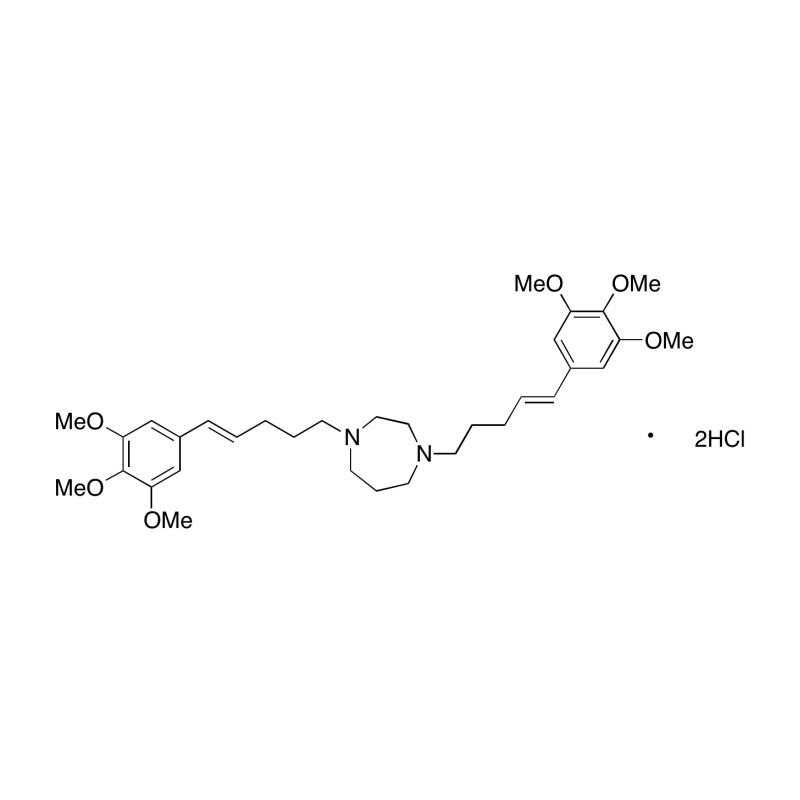产品
编 号:F238448
分子式:C33H50Cl2N2O6
分子量:641.67
分子式:C33H50Cl2N2O6
分子量:641.67
产品类型
规格
价格
是否有货
1mg
询价
询价
5mg
询价
询价
10mg
询价
询价
25mg
询价
询价
50mg
询价
询价
100mg
询价
询价
结构图

CAS No: 191089-60-8
产品详情
生物活性:
K-7174 dihydrochloride is an orally active proteasome and GATA inhibitor. K-7174 dihydrochloride is a cell adhesion inhibitor. K-7174 dihydrochloride induces cell apoptosis. K-7174 dihydrochloride shows antitumor activities, it can be used for the research of cancer.
体内研究:
K-7174 dihydrochloride (30 mg/kg; i.p. once daily for 9 days) reverses the decreasing of hemoglobin concentrations and reticulocyte counts by IL-1β or TNF-α.K-7174 dihydrochloride (75 mg/kg; i.p. once daily for 14 days) inhibits the tumor growth in vivo.K-7174 dihydrochloride (50 mg/kg; p.o. once daily for 14 days) inhibits the tumor growth in vivo and shows a better effect than intraperitoneal injection.Animal Model:ICR mice with IL-β or TNF-α injection
Dosage:30 mg/kg
Administration:Intraperitoneal injection; 30 mg/kg once daily for 9 days
Result:Increased erythropoietin (Epo) production, reticulocyte counts, and hemoglobin (Hb) concentrations.
Animal Model:NOD/SCID mice with murine xenograft
Dosage:75 mg/kg
Administration:Intraperitoneal injection; once daily for 14 days
Result:Significantly decreased tumor volume, but showed a significant body weight reduction after 10 days.
Animal Model:NOD/SCID mice with murine xenograft
Dosage:50 mg/kg
Administration:Oral gavage; once daily for 14 days
Result:Showed an anti-myeloma activity. Porved oral administration is more effective than intraperitoneal injection.
体外研究:
K-7174 dihydrochloride (10 μM; 1 h) inhibits the adhesion by VCAM-1 and its ligand.K-7174 dihydrochloride (1-30 μM; 1 h) dose-dependently suppresses the VCAM-1 expression with an IC50 value of 14 μM.K-7174 dihydrochloride (1-30 μM; 1 h) dose-dependently suppresses the induction of VCAM-1 mRNA by TNFα with an IC50 value of 9 μM.K-7174 dihydrochloride (10-20 μM; 24 h) dose-dependently rescues Epo production by Hep3B cells.K-7174 dihydrochloride (2.5-30 μM; 24 h) inhibits the binding activity of GATA.K-7174 dihydrochloride (0-25 μM; 72 h) inhibits MM cells growth and induces cell apoptosis.
K-7174 dihydrochloride is an orally active proteasome and GATA inhibitor. K-7174 dihydrochloride is a cell adhesion inhibitor. K-7174 dihydrochloride induces cell apoptosis. K-7174 dihydrochloride shows antitumor activities, it can be used for the research of cancer.
体内研究:
K-7174 dihydrochloride (30 mg/kg; i.p. once daily for 9 days) reverses the decreasing of hemoglobin concentrations and reticulocyte counts by IL-1β or TNF-α.K-7174 dihydrochloride (75 mg/kg; i.p. once daily for 14 days) inhibits the tumor growth in vivo.K-7174 dihydrochloride (50 mg/kg; p.o. once daily for 14 days) inhibits the tumor growth in vivo and shows a better effect than intraperitoneal injection.Animal Model:ICR mice with IL-β or TNF-α injection
Dosage:30 mg/kg
Administration:Intraperitoneal injection; 30 mg/kg once daily for 9 days
Result:Increased erythropoietin (Epo) production, reticulocyte counts, and hemoglobin (Hb) concentrations.
Animal Model:NOD/SCID mice with murine xenograft
Dosage:75 mg/kg
Administration:Intraperitoneal injection; once daily for 14 days
Result:Significantly decreased tumor volume, but showed a significant body weight reduction after 10 days.
Animal Model:NOD/SCID mice with murine xenograft
Dosage:50 mg/kg
Administration:Oral gavage; once daily for 14 days
Result:Showed an anti-myeloma activity. Porved oral administration is more effective than intraperitoneal injection.
体外研究:
K-7174 dihydrochloride (10 μM; 1 h) inhibits the adhesion by VCAM-1 and its ligand.K-7174 dihydrochloride (1-30 μM; 1 h) dose-dependently suppresses the VCAM-1 expression with an IC50 value of 14 μM.K-7174 dihydrochloride (1-30 μM; 1 h) dose-dependently suppresses the induction of VCAM-1 mRNA by TNFα with an IC50 value of 9 μM.K-7174 dihydrochloride (10-20 μM; 24 h) dose-dependently rescues Epo production by Hep3B cells.K-7174 dihydrochloride (2.5-30 μM; 24 h) inhibits the binding activity of GATA.K-7174 dihydrochloride (0-25 μM; 72 h) inhibits MM cells growth and induces cell apoptosis.
产品资料

